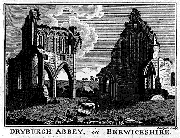History
Dryburgh Abbey,
about one hour south of Edinburgh.

Dryburgh Abbey
near St Boswells
The Scottish Borders


This image (left) is from an engraving of 1760, which is 62 years before Sir Walter Scott was buried beneath the chapel in the North Transept under the arches on the left.
It was only after Scott was laid to rest here that the abbey was restored and cared for, gardens made and parkland trees planted.
The surrounding park, as beautiful and secluded as it is today, is very different from the pastoral setting Scott knew. When Scotta was alive it was an expansive open field, grazed by sheep and cattle and dotted with blackthorn and gorse.
The White Canons of the Premonstratensian Order, who followed the rule of Saint Augustine, arrived at Dryburgh on St Martin's day in 1150, and within two years had consecrated the church of St Mary of Dryburgh.
Like Melrose and Newbattle Abbeys it was badly damaged by the English in 1385, but rebuilt and added to throughout the 1400's.
Many people who visit Dryburgh are struck by the atmosphere of tranquility. The monks who lived here observed the rule of silence, perhaps the essence of their intention lives on....

Door of the Chapter House
The Chapter House was used by the Order for daily readings from spiritual texts.

Door from the Cloisters
This door connects the cloister garth, a square open space once surrounded by a covered walkway, to the main church.
Dryburgh Abbey, near St Boswells, is open to the public. It is best to check Historic Scotland on opening times before visiting.
Related pages:
- JMW Turner's view of Dryburgh Abbey of 1831.
- Melrose Abbey
